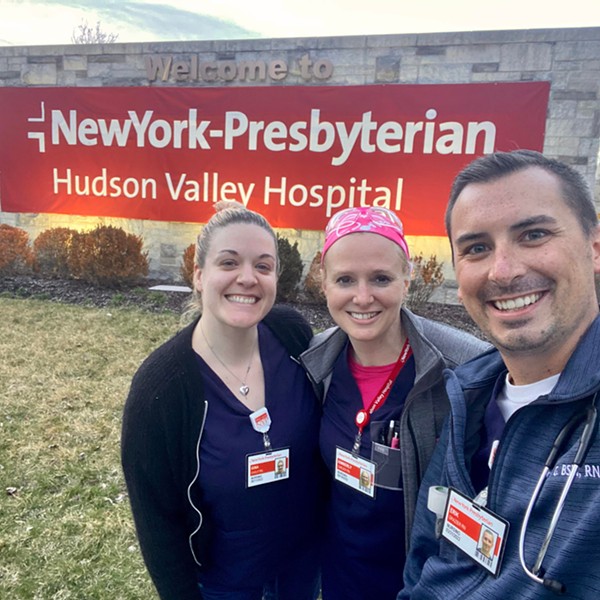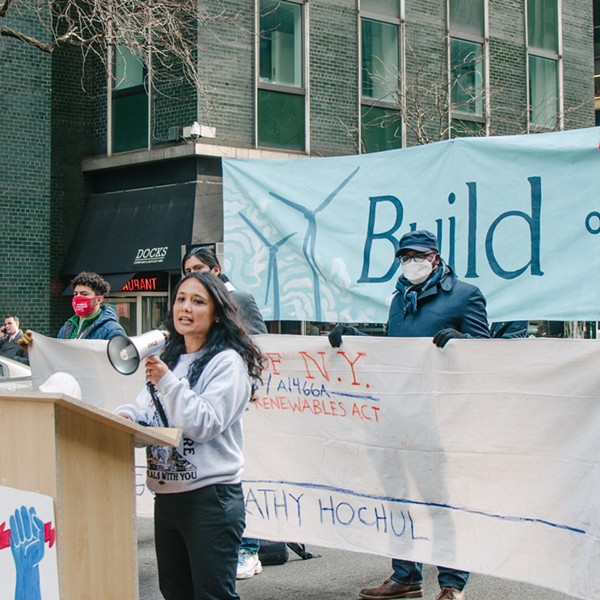Amid last summer’s social upheaval following the murder of George Floyd, the spectacle of protests in small-town, rural, and “middle” America fascinated national news outlets. Legacy media dispatched reporters nationwide to narrativize a phenomenon that would have been anachronistic five years ago. Salon’s executive editor, for example, waxed poetic about the Catskills’ village of Delhi and its 700-person protest. “In relative terms, it’s as if a protest in New York City had drawn more than a million people,” reads his June 2020 piece.
The popular media narrative about these places portrays them as conservative strongholds resistant to social change, with last summer being the moment anti-racism and police reform activism finally infiltrated rural, white America.
But in the Catskills region, last summer’s protests and accompanying policing debates exacerbated existing concerns about law enforcement and its role. Rural America has always been left out of the nation’s police reform debates, with cities like New York taking center stage. Rural policing agencies themselves say there’s no comparison between how they operate and how urban police departments function. “We just have [10] villages and 18 towns, and our police agencies are very intimately involved in their communities,” says Delaware County Sheriff Craig DuMond.
While the policing and political landscapes in the Catskills may be different from that of major cities, those differences don’t quite equal a better quality of life. For some of Delaware’s few Black residents, their personal safety concerns include racial profiling and vigilantism. “There are towns in this area that border on being sundown towns,” says Delaware County resident Christina Hunt Wood, who is Black and biracial. And with Delaware and Sullivan counties having the highest rates of gun suicides and opioid overdoses in New York, residents and experts fret over law enforcement’s position at the forefront of the crises.
Governor Andrew Cuomo’s Executive Order 203 forced the state’s roughly 500 police agencies to confront their respective communities’ concerns with local policing. Otherwise, they’d lose state funding. Activists, experts, and residents in Delaware and Sullivan say they struggled to show local officials tangible solutions to their communities’ problems. Some ultimately resigned from the police reform committees officials convened, while others demanded their names be removed from reform plans. A common struggle among their frustrations: getting officials to see that there are, indeed, problems.
“It’s Only Not a Problem Because You’re Not Seeing the Problem”
Delaware County has four town and village policing departments, but the Sheriff’s Office covers the most ground in the county. During its EO 203 process, the Sheriff’s Office circulated two countywide surveys seeking to gauge the policing concerns and recommendations of residents. Simon Purdy, an assistant professor of criminal justice and sociology at SUNY Delhi and author of the second survey, says the county fumbled its first attempt by asking residents to simultaneously divulge their experiences with racial profiling and their home addresses. “If you have any idea about how to research things, that’s just not how you ask that question,” he says. “You don’t ask someone such a sensitive question and then ask for their address.”
The county opened the second survey for two weeks, and Purdy had one week to analyze the results—the tightest deadline he’s ever had for a survey. Social media and a press release were officials’ chief means of getting the word out, and paper versions of the survey were only available by request. In a rural county with an aging population and lack of reliable internet access, Purdy describes these methods as woefully inadequate.
“These issues alone make a predominately online survey method less representative, and unfortunately a two-week data collection period made any other practical method, such as mailing the survey, impossible,” he says.
This didn’t stop officials from taking the survey’s results at face value, and misconstruing Purdy’s analysis. “I think that the survey results reflected what’s actually taking place: that minority residents feel comfortable and safe in Delaware County,” says Sheriff DuMond. But 40 percent of the survey respondents said they didn’t feel comfortable reporting police misconduct to the department.
And with so few people willing to disclose their race, Purdy says the results are anything but conclusive. His proposals for more research and to record racial demographics for traffic stops, which could be used to monitor possible profiling, were also ignored. “This was rushed by design, so it was never going to be a fully accurate depiction of Delaware County,” he says. “If we’re not willing to do the work to actually look for those problems, we’re never going to find them. It’s only not a problem here because you’re not seeing the problem.”
Indeed, rural policing agencies that serve predominantly white communities frequently decry searching for a problem where they declare there is none. This sentiment is shared by the larger criminal justice apparatus in Delaware. “I think one of the problems we’re gonna have with this committee is finding problems where they don’t exist,” Delaware Public Defender Joe Ermeti said during a county police reform meeting.
In Delaware’s case, the county’s two most visible communities of color are its reclusive Muslim enclaves: the Sufi community Osmanl? Dergâh? in Sidney, founded in 2003, and the community of Islamberg in Hancock, founded by the Muslims of America in the 1980s. Anti-Muslim extremists often target the latter, catalyzed by false rumors that the community produces homegrown terrorists. Local law enforcement agencies like the Sheriff’s Office forged ties with Islamberg with the goal of thwarting these threats.
When asked if he believes officials did enough to connect with people of color during the county’s 203 process, DuMond said that his office has a strong relationship with both Muslim enclaves. But those communities don’t encompass all residents of color in Delaware, and people of color often feel unseen, invalidated, and unworthy in majority-white rural localities.
Wood, an organizer who has lived in Delaware County for years, says the county’s conservative small-town politics exacerbate this culture. “[The sheriff] will never speak out against it because there’s a protection of the good old boys’ network,” she says. “People who are here don’t want to speak out because they don’t want to put a target on their back.”
Wood actively struggles against that. The 45-year-old multimedia artist didn’t always think about policing and public safety in the area. But after Dylann Roof massacred nine Black worshippers at the Emanuel African Methodist Episcopal Church in Charleston, South Carolina in 2015, she says Confederate flags proliferated across the county.
Wood cofounded Fair for All, a group that has been working since 2017 to get the Delaware County Fair to ban the sale of Confederate flags. At the time, DuMond was chair of the local Cornell Cooperative Extension chapter that partners with the fair. The advocacy group demanded that the chapter and DuMond denounce the flag’s sale at the event, but ultimately the sheriff only supported a ban on its display, leaving vendors free to sell it anyway. Across the fairgrounds is a cemetery honoring the 144th New York regiment of the Union Army, recruited entirely from the county. The irony isn’t lost on Wood.
DuMond maintained a commitment to diversity and inclusion during meetings on the merchandise. But Wood says the sheriff’s stance on the sale of the memorabilia helps perpetuate an environment that drives people of color away, and forces some Black individuals and families to consider parts of the county sundown towns—places that exclude nonwhite people through passive and active intimidation. During a Black Lives Matter caravan in Walton, a town Wood says she often tries to avoid, a resident sped down the road and did a U-turn, attempting to hit those present. “There’s just an absolute refusal to acknowledge there’s a reason why the space is so white,” she says. “And the reason why is because they allow threatening symbols to go willy-nilly.”
DuMond says he doesn’t see these threats in Delaware: “None of that came out as a result in the community survey,” he says. “And dealing with our communities for the past 36 years here, I’m just not seeing that as a problem.”
For some, the sheriff’s apparent disconnect with residents of color grew into a chasm in the summer of 2020. Amid national calls to dismantle institutional racism in policing and other American institutions, DuMond and the New York State Sheriffs’ Association sponsored legislation that civil rights groups say was an attempt to “shield officers from accountability.” One bill proposes raising resisting arrest to a Class E felony; another would make the failure to retreat to a Class D felony.
“Under this proposal, the killings of Philando Castile and George Floyd would never have been caught on tape,” reads the Auburn/Cayuga branch of the NAACP’s letter to Cayuga County Sheriff Brian Schenck.
Darwin Johnson, a Delaware resident of seven years who is Black, moved to the county to leave behind a life of over policing in major American cities. He’d never had any specific qualms with the Delaware Sheriff’s Office. That changed last summer.
"These laws they’re asking for are acts of violence,” Johnson says. “I feel like they want to put people in a position where their lives or freedom can be taken without any consequences. It feels like they want to be above the law. And that bothers me.”
Tackling a Status Quo of “Pain, Suffering, Death”
The face of America’s drug epidemic and the target of the “War on Drugs” used to be the urban metropolis. But over the last two decades, opioid overdoses have skyrocketed in rural America. Urban areas still lead in overdoses, but much like with mental health, rural counties such as Delaware and neighboring Sullivan are struggling to make do with fewer resources than their more densely populated neighbors.
“The availability of mental health services and addiction services does not match the need in rural America,” says Bill Hayes, a member of the National Alliance of Mental Illness Delaware and Otsego County chapter.
In New York as with the rest of the country, mental health and substance use disorder services are concentrated in urban areas. For example, Delaware doesn’t have an inpatient psychiatric unit, and used to refer residents to neighboring Ulster County. At the beginning of the pandemic, WMCHealth transferred those services to MidHudson Regional in Poughkeepsie. That’s an even greater trek for Delaware County residents, who have zero access to public transit. The closest inpatient mental health resource is a tiny 10-bed unit in neighboring Otsego County, and the only inpatient addictions services are at Delaware Valley Hospital in Walton, an hourlong drive from the eastern end of the county.
County officials in the Catskills often shift the onus for these resource gaps to the state. “Much blame can be laid on New York State for the cuts over the past 25 years to the Office of Mental Health (OMH) and the closure of psychiatric treatment centers,” Sullivan County’s final police reform plan reads. “This has put police officers on the front line of the mental health crises.”
The patchwork system of mental health and drug treatment options often leaves law enforcement as the default first responders for local behavioral crises, which puts both parties in an unwelcome scenario: people with untreated mental illness are 16 times more likely to be killed during a police encounter, according to a 2015 study. For interactions that don’t end in tragedy, those with untreated mental illness or substance addiction often get caught in a cycle of incarceration and court appearances.
Some activists and residents, however, say that the lack of funding for behavioral health services is a convenient excuse for local officials. In the absence of government action, private citizens are left to lobby state representatives for funding and local nonprofits to form public-private partnerships. Meanwhile, communities continue to suffer.
“What’s immoral is that people become comfortable with, ‘We don’t have the resources,’” says Martin Colavito, an organizer for the Sullivan-based Committee for Equity & Justice, a subcommittee of Sullivan Allies Leading Together (SALT). “So all of a sudden pain, suffering, death, illness is all allowed because we don’t have resources.”
Other advocates aren’t as critical of government officials, acknowledging that insufficient behavioral health care is ultimately due to underfunding by the state. A mandate in the form of Cuomo’s EO 203—which itself is unfunded, and carried the threat of losing further state funding—lodged rural counties between a rock and a hard place. But there is still some disappointment on the part of advocates.
“We did not criticize Sheriff [DuMond], or his deputies, or dispatchers,” says Hayes. “I am frustrated, but I’m trying to be clear [with the sheriff] about what advocates want to happen. Part of that is an acknowledgement of our offers of support to his office.”
DuMond also acknowledges that because of resource deficiencies in Delaware, law enforcement, including his office, is often at the forefront of these crises. When asked if he was frustrated with county leadership, DuMond defended the current efforts. “I think that the county executive is doing everything that the county executive can do with the resources that are available to address the problems,” he says. “And from my take on it, I believe that we’re doing a pretty good job of addressing those issues.”
(The River requested an interview with Delaware County Chairman Tina Molé but was referred to the county’s EO 203 plan. The Sullivan County Sheriff’s Office, which previously stated it handles any policing and police reform inquiries, did not return multiple requests for comment.)
DuMond says he’s proud of the additional initiatives that came out of the EO 203 process to bolster his office’s response to behavioral health crises. These programs include mental health response training for officers through the Chenango Health Network, and a referral system where deputies can connect individuals to drug, alcohol, and mental health services. In Sullivan, the Sheriff’s Office committed to receiving training already provided by New York State.
Hayes worries about Delaware officers’ ability to recognize the right resources for those who need them. And while a referral system is a step in the right direction, he says this still runs up against the availability of resources and programs in the area.
Sullivan’s 203 plan includes a recommendation that, besides the county’s mobile crisis team, social workers and peer counselors should respond to “non-volatile calls for service” often assigned to the police. Not mentioned is that Colavito is organizing this effort, according to Dayna Halprin, another SALT organizer. “He’s called meetings with people from Sullivan County public health, the chair of the family services committee, officers from the police departments, and state elected officials,” they say. “The people who are actually getting paid to do this, but aren’t taking the initiative to make it happen in the county—it’s really a disgrace to the taxpayers who fund their salaries.”
Colavito provides both a self-deprecatory, yet impassioned, critique of county leadership: “I may be the dumbest guy in the room, but I’m also the dumbest guy in the room with people I love whose health is at stake.”
Read Delaware County’s full police reform report here, and Sullivan County’s final report here.
Read our previous article about the EO 203 process in four mid-Hudson Valley communities here.




















